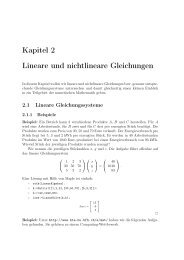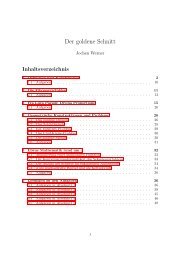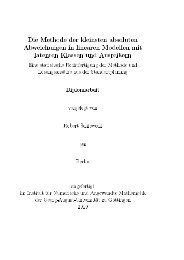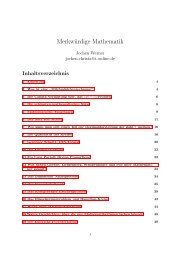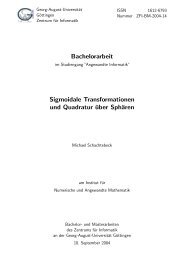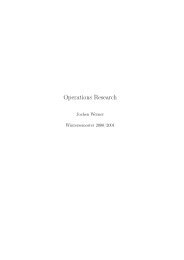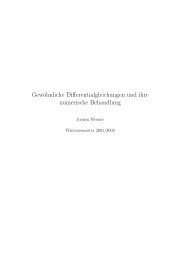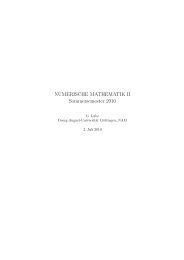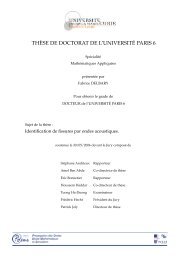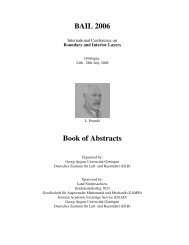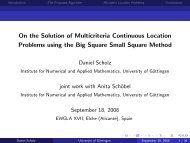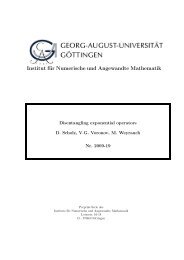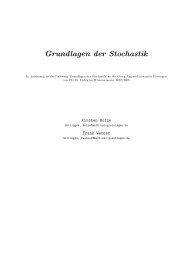Georg-August-Universität Göttingen - Institut für Numerische und ...
Georg-August-Universität Göttingen - Institut für Numerische und ...
Georg-August-Universität Göttingen - Institut für Numerische und ...
You also want an ePaper? Increase the reach of your titles
YUMPU automatically turns print PDFs into web optimized ePapers that Google loves.
<strong>Georg</strong>-<strong>August</strong>-<strong>Universität</strong><br />
<strong>Göttingen</strong><br />
Integrating Line Planning, Timetabling, and Vehicle<br />
Scheduling:<br />
A customer-oriented approach<br />
M. Michaelis and A. Schöbel<br />
Nr. 2008-04<br />
Preprint-Serie des<br />
<strong>Institut</strong>s <strong>für</strong> <strong>Numerische</strong> <strong>und</strong> Angewandte Mathematik<br />
Lotzestr. 16-18<br />
D - 37083 <strong>Göttingen</strong>
Integrating Line Planning, Timetabling, and<br />
Vehicle Scheduling: A customer-oriented<br />
approach ∗<br />
Mathias Michaelis Anita Schöbel<br />
March 28, 2008<br />
Abstract<br />
Given an existing public transportation network, the classic planning<br />
process in public transportation is as follows: In a first step, the lines are<br />
designed; in a second step a timetable is calculated and finally the vehicle<br />
and crew schedules are planned. The drawback of this sequence is that the<br />
main factors for the costs (i.e. the number of vehicles and drivers needed)<br />
are only determined in a late stage of the planning process.<br />
We hence suggest to reorder the classic sequence of the planning steps:<br />
In our new approach we first design the vehicle routes, then split them to<br />
lines and finally calculate the timetable. The advantage is that costs can<br />
be controlled during the whole process while the objective in all three steps<br />
is customer-oriented.<br />
In the paper we formulate this approach, discuss the complexity of<br />
the resulting problems, and present a heuristic which we applied within a<br />
case-study, optimizing the local bus system in <strong>Göttingen</strong>, Germany.<br />
1 Motivation and related literature<br />
The strategic planning process in public transportation is usually divided<br />
in the planning steps depicted in Figure 1. In this paper we are interested<br />
in the following three steps: line planning, timetabling, and vehicle<br />
scheduling.<br />
To sketch these three steps, let PTN = (V, E) be a directed graph representing<br />
the public transportation network. It consists of a set of (potential)<br />
stops or stations V and a set of direct connections between them.<br />
∗ This work was partially supported by the Future and Emerging Technologies Unit of EC<br />
(IST priority - 6th FP), <strong>und</strong>er contract no. FP6-021235-2 (project ARRIVAL).<br />
1
infrastructure<br />
lines and frequencies<br />
timetable<br />
vehicle routes<br />
crew schedules<br />
Delay−management,<br />
Re−Scheduling,...<br />
infrastructure<br />
vehicle routes<br />
lines<br />
timetable<br />
crew schedules<br />
Delay−management,<br />
Re−Scheduling,...<br />
Figure 1: The classic planning phases in public transportation (left) compared to the<br />
sequence used in this paper (right).<br />
Line planning. A line l is a path in the public transportation network<br />
PTN. The frequency fl of a line l says how often service is offered along line<br />
l within a (given) time period I. A line concept is a set of lines together<br />
with their frequencies.<br />
In most research papers it is assumed that a line pool of potential lines is<br />
already given. The goal is to choose a set of lines from the pool and to<br />
assign frequencies to the lines chosen. Unfortunately, even the feasibility<br />
problem (finding frequencies such that the constraints at each edge are<br />
satisfied) is NP hard (see [Bus98, CvDZ98]).<br />
One distinguishes between cost-oriented models (see e.g. [CvDZ98, Zwa97,<br />
Goo04, BLL04, GvHK06]) in which the line concept has to cover a given<br />
demand with smallest possible costs, and customer-oriented models where<br />
a budget is given that should be used in a way that is “best” for the passengers.<br />
Examples for customer-oriented objective functions are to maximize<br />
the number of direct travelers ([BKZ96, Bus98]) or to minimize the traveling<br />
time of the passengers (see [BGP05, BP05, SS06, Sch05], where the latter<br />
two also took the time for transfers into account). Designing lines which<br />
can compete with the private mode has been studied in [LnMO06, LMO05].<br />
Note that [CvDZ98] already considered the vehicle schedules of later planning<br />
steps.<br />
There are rather few papers in which the lines are constructed during the<br />
process of line planning. In the very first paper about line planning, Patz<br />
([Pat25]) starts with a line for each OD pair and iteratively eliminates lines<br />
2
y a greedy approach. A similar greedy heuristic is due to [Son77]. More<br />
recently, [UP95] and [Qua03] suggest constructive approaches, the latter<br />
also dealing with timetabling within the next planning step. Integration<br />
of line planning and periodic timetabling has also been done in [LM06].<br />
In this paper we suggest a constructive heuristic using a customer-oriented<br />
approach.<br />
Timetabling. Given the set of stations V and the set of vehicles F , a<br />
timetable consists of two functions π arr : V × F → IN, π dep : V × F → IN<br />
assigning a departure time and an arrival time to each vehicle at each<br />
station. To avoid indices event activity networks are used in timetabling<br />
(see [Nac94]) in which the events consist of all arrivals and departures of<br />
all vehicles at all stations. The events are linked by edges corresponding<br />
to three types of activities: driving activities of vehicles between stations,<br />
waiting activities of vehicles at stations, and transfer activities to account<br />
for passengers changing busses or trains.<br />
We have to distinguish between periodic and aperiodic timetabling. The<br />
latter can be efficiently solved by shortest path techniques while the former<br />
is NP-hard (see [Nac94]). The basis for tackling periodic timetabling is the<br />
periodic event scheduling problem (PESP) originally introduced in [SU89].<br />
There are many extensive studies about timetabling, we refer to [Pee02,<br />
Lie06] and references therein. Current approaches deal with integration<br />
aspects (e.g. [LM04]) or robustness issues ([KDV07, LSS + 07, FSZ07]).<br />
Vehicle Scheduling. If the lines and the timetable are given one can<br />
define the trips which have to be served, i.e. the minimal pieces which have<br />
to be operated by the same bus (usually between start and end station of a<br />
line). For each trip we have given its start station with its departure time<br />
and its end station with its arrival time. Two trips trip1 and trip2 can be<br />
served by the same bus if the arrival time at the end station of trip1 plus<br />
the time needed to drive from the end station of trip1 to the start station<br />
of trip2 is smaller than the departure time at the start station of trip2.<br />
The goal is to find a cost-minimal assignment between busses and trips<br />
such that each trip is covered by exactly one bus and the schedules of all<br />
vehicles are feasible. While the multi-depot case is NP-hard (see [BCG87]<br />
and [PDHH06] for a comparison of different heuristics), the single-depot<br />
case can be solved polynomially. Approaches include decomposition models<br />
([Sah72]), assignment models ([Orl76]), transportation models ([GS78]) or<br />
network flow models ([DP95]). An excellent survey paper dealing with bus<br />
scheduling is [BK06], railway issues are treated in [Mar06].<br />
Research in vehicle scheduling includes practical extensions as multiple vehicle<br />
types (e.g. [Löb97]), route constraints (e.g.[KGS06]), or maintenance<br />
issues. Recently, robustness issues are considered within the framework of<br />
ARRIVAL [ARR].<br />
3
In contrast to the approaches in the literature and to the classic planning<br />
process in public transportation, we follow a new approach in this paper.<br />
We start by determining the routes of the vehicles, then add a timetable<br />
and split them to lines.<br />
We repeat the most crucial notation that will be used throughout this text.<br />
• A line is a path in the PTN along which service is offered.<br />
• A timetable specifies the departure and arrival times of each vehicle<br />
at each station.<br />
• For the vehicle schedules we distinguish between the vehicle routes<br />
which are given as paths in the PTN and the vehicle schedule which<br />
assigns arrival and departure times to the routes.<br />
Since we are looking for a periodic schedule we assume that one common<br />
period T is given after which everything is repeated. We plan for only one<br />
period but take the periodicity into account when evaluating our objective<br />
function.<br />
2 Planning an attractive transportation<br />
system<br />
The main idea of our new approach is to start the whole process by designing<br />
the vehicle routes. A vehicle route is the path a vehicle drives in<br />
the PTN given as a sequence of stops in V or as a sequence of edges e ∈ E.<br />
The set of all routes in the final public transportation system is denoted<br />
by U. Each vehicle route u ∈ U has a frequency fu specifying how many<br />
trips should be offered along the route within the same planning period<br />
and a schedule tu assigning an arrival and a departure time to each stop<br />
of the route. It will turn out that these values (U, f, t) are sufficient as<br />
variables, i.e, not only the vehicle schedules, but also the lines and the<br />
timetable together with their costs and attractiveness can be determined<br />
if U and fu, tu are known for all u ∈ U.<br />
We remark that the routes are planned as circles such that they can be<br />
repeated in the next period.<br />
Let us consider the ingredients we need for the problem.<br />
The public transportation network PTN =(V,E). For each edge<br />
e in the PTN we determine two lengths: dbus(e) is the time a bus needs for<br />
running between i and j, while dpriv(e) is the time needed in the private<br />
mode i.e. by foot or by car. For most edges, dpriv(e) ≤ dbus(e). The<br />
duration of a route is defined as the sum of all edge lengths (in the public<br />
mode) of edges contained in the route, i.e.<br />
dur(u) = �<br />
dbus(e).<br />
e∈u<br />
4
Footpaths connecting nearby stops (e.g. on the two different sides of a<br />
street) are also included in our model to allow passengers to walk from one<br />
stop to another.<br />
In our work we distinguish between stops V and locations B, where the<br />
latter is a set of stops with the same name. Usually two stops (on either<br />
side of a road) form a location. In a one-way street there may be locations<br />
consisting of only one stop, whereas a location near an intersection may<br />
consist of four stops. The reason for aggregating the stops is that the<br />
evaluation of a public transportation system is based rather on locations<br />
than on stops since customers do not mind on which side of a street they<br />
depart or arrive.<br />
Data about the potential demand. Our goal is to design an attractive<br />
public transportation system, i.e. one that meets the demand of the<br />
citizens. We are interested not only in improvements for existing customers<br />
but also in attracting new customers. Hence we use an origin-destination<br />
matrix representing the complete demand. This matrix is certainly not<br />
based on stops. It is given due to demand regions (called cells). By assigning<br />
cells to their closest locations we obtain an origin-destination matrix<br />
OD ∈ ZZ |B|×|B| . (Details are given in Section 4.) In the following let us<br />
assume that for each pair i, j ∈ B of locations the value ODij represents<br />
the number of persons who want to travel from i to j, i.e. the potential<br />
number of customers for this OD-pair.<br />
Given an OD-pair of locations i, j a customer is interested in a “good” (i.e.<br />
a fast) trip from i to j in the public transportation system. These trips<br />
will be called passengers’ paths between i and j.<br />
Constraints. We consider two major constraints: the costs and the<br />
capacity of our system.<br />
The costs of a public transportation system are mainly determined by the<br />
number of vehicles running per day, since this number determines not only<br />
the investment costs but also fixes the number of drivers and conductors<br />
needed. Our budget constraint hence bo<strong>und</strong>s the number of vehicles N<br />
that we are allowed to use. Note that the number of vehicles needed<br />
(within one period of time) can be determined by the vehicle routes and<br />
their frequencies, namely by<br />
� �<br />
dur(u) · fu<br />
number of vehicles for route u =<br />
. (1)<br />
T<br />
In our construction process we take care of designing vehicle routes u with<br />
a duration dur(u) a bit less than one time period T . In this case we obtain<br />
fu as the number of busses necessary for route u.<br />
There is another constraint we are taking into account: we ensure that the<br />
space available for busses is sufficient at each of the stops. As parameters<br />
5
we have given a capacity cap(v) indicating how many busses are allowed<br />
to be at the stop v at the same time.<br />
We remark that there are a lot of other constraints in practice. These<br />
include breaks for the drivers, slack times to make the timetable more<br />
robust and constraints for the specific shape and structure of the lines.<br />
They can be considered when constructing the vehicle routes in the first<br />
phase of our algorithm.<br />
Objective function. We define the attractiveness of a public transportation<br />
system as the average probability that a (potential) traveler<br />
decides to use public transportation instead of the private mode.<br />
objective function hence is<br />
Our<br />
max �<br />
(2)<br />
(i,j)∈B×B<br />
pijODij<br />
where ODij is the potential demand between locations i and j and pij is<br />
the probability that a person who wants to travel between stops i and j<br />
uses public transportation. The probability pij depends on many factors.<br />
Talking to practitioners we decided to focus on<br />
pwij: the average waiting time for trips from i to j and on<br />
pdij: the travel time of public transport (compared to the travel time of<br />
the private mode) between i and j<br />
to determine the probability that a person decides to use public transportation<br />
for his or her trip from i to j. The idea to compare the traveling<br />
times in public and private mode has also been used by Laporte, Mesa and<br />
Ortega, see [LMO05].<br />
In the following we show in detail how to estimate pij. We start from a<br />
solution (U, f, t) consisting of vehicle routes U with their frequencies f and<br />
their schedules t.<br />
We are interested in (the number and quality of) all possibilities how a<br />
passenger can travel from i to j. Given (U, f, t) such a passenger path is<br />
specified by<br />
• the routes and stops it uses, and<br />
• by the arrival and departure times of all its stops.<br />
Note that two consecutive stops of a passenger path are either contained<br />
in the same route or the passenger has to transfer between two vehicles.<br />
In order to find all possible passengers’ paths we set up the timetable<br />
graph defined by the PTN and our solution (U, f, t). This graph contains<br />
all the relevant information for a timetable information system and allows<br />
to determine the set of all possible passengers’ paths Pij from i to j for<br />
each pair of locations i, j ∈ B, see [BDW07] for a recent comparison of<br />
methods.<br />
6
For each p ∈ Pij we collect<br />
dep(p) = starting time at i<br />
arr(p) = arrival time at j<br />
dur(p) = arr(p) − start(p)<br />
= time needed to travel from i and j using path p<br />
We then take the best paths of this set. To this end we use the smallest<br />
possible traveling time<br />
dur min<br />
ij<br />
and fix a value λ to determine<br />
= min dur(p)<br />
p∈Pij<br />
Gij = {p ∈ Pij : dur(p) ≤ λ · dur min<br />
ij and<br />
there does not exist a path p ′ ∈ Pij satisfying<br />
dep(p ′ ) ≥ dep(p), arr(p ′ ) ≤ arr(p), dur(p ′ ) ≤ dur(p)} (3)<br />
as the set of “good” passengers’ paths between i and j. With the help of<br />
this set, we can estimate the two parameters pd and pw to estimate the<br />
probability that a customer uses public transportation when traveling from<br />
i to j:<br />
pd: We compare the travel time in public transport with the travel time<br />
using the private mode, i.e. we calculate<br />
where public ij =<br />
P<br />
p∈G ij dur(c)<br />
|Gij|<br />
rij = private ij<br />
public ij<br />
denotes the average travel time in pub-<br />
lic transportation and privateij is the travel time in private transportation.<br />
The probability that a customer accepts public transportation<br />
is modeled by the following piecewise linear function (see<br />
left picture of Figure 2):<br />
⎧<br />
⎨<br />
pdij = pd(rij) =<br />
⎩<br />
1<br />
α2−rij<br />
α2−α1<br />
0<br />
:<br />
:<br />
:<br />
rij ≤ α1<br />
α1 < rij ≤ α2<br />
rij > α2<br />
for two parameters α1 and α2.<br />
pw: We determine the average waiting time waitij until the next trip in<br />
Gij starts. To this end, we sort the passengers’ paths in Gij according<br />
to dep(c) to obtain a list dep(c1) < dep(c2) < . . . < dep(cK) with<br />
k ≤ |Gij|. (Note that there are no paths with the same departure<br />
time in Gij.) This yields K − 1 intervals<br />
Ik = [dep(ck), dep(ck+1)], j = k, . . . , K − 1.<br />
7
probability<br />
to accept<br />
1<br />
0<br />
a1 a2 travel time ratio<br />
1.1 2.4 private:public<br />
probability<br />
to accept<br />
1<br />
0<br />
b1<br />
10 min<br />
b2<br />
45 min<br />
waiting time to<br />
next connection<br />
Figure 2: Probability for accepting the average waiting time and the ratio for the<br />
travel time for a path from i to j.<br />
We assume that the demand is distributed evenly within a period,<br />
i.e. at each minute we have the same probability that a person wants<br />
to start his or her journey. If a person arrives within interval Ik, his<br />
minutes. Hence we estimate<br />
or her average waiting time is |Ik−1|<br />
2<br />
wij =<br />
K�<br />
k=1<br />
|Ik|(|Ik| − 1)<br />
2<br />
as the average waiting time for the next trip from i to j. Again,<br />
the probability that a customer accepts the average waiting time is<br />
modeled by a piecewise linear function (see right picture of Figure 2)<br />
⎧<br />
⎪⎨<br />
pwij = pw(wij) =<br />
⎪⎩<br />
β2−wij<br />
β2−β1<br />
depending on the parameters β1 and β2.<br />
1 : wij ≤ β1<br />
: β1 < wij ≤ β2<br />
0 : wij > β2<br />
Assuming that the probability pwij to accept the average waiting time<br />
is independent of the probability pdij to accept the travel time ratio, we<br />
finally get<br />
pij = pwij · pdij<br />
and are hence able to calculate att(U, f, t) according to (2).<br />
Note that the two functions depend on the customers’ behavior which is<br />
represented by the parameters a1, a2, b1, b2 and λ.<br />
In our case study these parameters are set to<br />
• a1 = 1.1, a2 = 2.5 meaning that everybody accepts an increase of<br />
10% of the travel time, but nobody would accept an increase by the<br />
factor 2.5,<br />
8<br />
,<br />
(4)
• b1 = 7.5, b2 = 36, i.e. an average waiting time of 7.5 minutes (referring<br />
to a connection offered four times an hour) is accepted by all<br />
potential passengers, while an average waiting time of more than 36<br />
minutes is not accepted at all. For public transportation at night we<br />
increased these values to 10 and 45.<br />
• Due to Definition 3 of the set of good passengers’ paths, λ has also an<br />
influence on the probability pij. In our case study we chose λ = 1.3.<br />
Note that the specific values for the parameters have been chosen after<br />
discussion with practitioners. They make sense for the local properties of<br />
<strong>Göttingen</strong>, but need not hold in other environments. For example, in large<br />
cities, we suggest to choose smaller values for b1 and b2.<br />
Our approach can now be summarized:<br />
Phase 1: Design the routes U and the frequencies f of the vehicles.<br />
Phase 2: Split the routes to lines.<br />
Phase 3: Find a timetable t.<br />
The three phases will be described in more detail in Section 5. We remark<br />
that splitting the vehicle routes to lines is just to obtain a nice graphical<br />
representation of the system, but has no influence on its attractiveness or<br />
on its costs (since the lines are not needed to calculate the costs or the<br />
shortest passengers’ paths).<br />
Summarizing, in our problem (P) we are looking for a set of vehicle routes<br />
U, with frequencies fu ∈ IN for each u ∈ U and a timetable tu for each<br />
u ∈ U. A solution is denoted as (U, f, t). Our goal is to find a solution<br />
(U, f, t) with less than N vehicles minimizing att(U, f, t).<br />
3 Complexity<br />
Not very surprisingly, the integrated problem of planning lines, a timetable<br />
and the vehicle schedules is NP hard. More detailed, the following results<br />
hold.<br />
Theorem 3.1.<br />
• It is NP-hard to design the routes of the vehicles, even if the timetable<br />
is not relevant, i.e. Phase 1 of (P) is NP-hard.<br />
• It is NP-hard to find an optimal timetable, even if the vehicle routes<br />
are given, i.e. Phase 3 of (P) is NP-hard.<br />
• The variant (P-special) in which all routes must contain a stop of a<br />
given central location, all frequencies have to be one, the set of edges<br />
with their lengths in the public and in the private mode coincide and<br />
the timetable is not relevant is still NP-hard.<br />
9
We present the proof for the third statement (which also proves the first.)<br />
The proof of the second statement can be fo<strong>und</strong> in [Mic07]; intuitively it<br />
also follows from the NP-hardness of periodic scheduling.<br />
More formally, the third problem (P-special) can be described as follows:<br />
(P-special) Given a PTN = (V, E) with edge lengths d(e) = dbus(e) =<br />
dpriv(e) for each e ∈ E, a set of locations B, a central location lc and<br />
an origin-destination matrix OD, values λ, a1, a2, b1, b2 describing the<br />
users’ behavior, a time period T , and two integers N and U, does there<br />
exist a solution (U, f, t) satisfying<br />
• lc ∩ u �= ∅ for all u ∈ U,<br />
• fu = 1 for all u ∈ U,<br />
• �<br />
u∈U<br />
�<br />
e∈U l(e) ≤ N (i.e. it can be run with N busses)<br />
and such that<br />
• �<br />
i=1<br />
�<br />
j=1 pijODij ≥ U ?<br />
Proof. We use a reduction from the knapsack problem which is known<br />
to be NP-hard (see [GJ79]). It is defined as follows: Given two natural<br />
numbers W, B and a set of items D with weights w(d) ∈ IN and benefits<br />
v(d) ∈ IN for all d ∈ D, does there exist a subset K ⊆ D of items with a<br />
total weight of no more than W and a total benefit of at least B?<br />
Given an instance of (Knapsack), an instance of (P-special) is to be constructed.<br />
Define a central location lc and a location ld for each item in<br />
d ∈ D and add exactly one stop sc and sd for all d ∈ D for each of the<br />
locations. Connect all stops sd star-wise to the central stop sc with a pair<br />
of inverse edges. The lengths l(e) of these two edges e ∈ {(sd, sc), (sc, sd)}<br />
is set to w(d)·T<br />
2 for both the public and the private mode for each item<br />
d ∈ D. We furthermore define the demand between the central location<br />
and the locations ld as<br />
ODlc,ld<br />
:= v(d) for each d ∈ D<br />
and zero for all other pairs. For an illustration of this instance of (P-special)<br />
see Figure 3.<br />
For the customers’ behavior we set β1 and β2 so large that all waiting times<br />
will be accepted. Furthermore, we set α1 ≥ 1 such that the customers<br />
accept the public mode if the traveling time is the same as in the private<br />
mode. This means that all existing paths are accepted by the passengers,<br />
independently of their timetables. Finally, we define N := W and U := B.<br />
We now show that (P-special) has a feasible solution if and only if (Knapsack)<br />
has a feasible solution.<br />
10
item d<br />
s<br />
d<br />
ud circulation<br />
sc<br />
central<br />
station<br />
Figure 3: Reduction of (P-special) to (Knapsack).<br />
(Knapsack) has a feasible solution: Let a feasible solution for (P-special)<br />
be given with a set U of routes. Every route contains the central<br />
stop lc and at least one other stop. Without loss of generality we<br />
can assume that the route contains exactly one other stop (otherwise<br />
we split it to feasible routes for each other stop sd it contains,<br />
since 2 · dur(e) ≥ T ). We define ud := (sc, sd, sc) as the route passing<br />
through stop sd.<br />
We now show that<br />
K := {d ∈ D : sd ∈ u for some u ∈ U} = {d ∈ D : ud ∈ U}.<br />
is a feasible solution of (Knapsack):<br />
= w(d)T time. Hence, in order to run<br />
this route with a frequency of one, w(d) busses are necessary, see<br />
(1). Since the solution U is feasible for (P-special) we conclude<br />
• The route ud takes 2· w(d)·T<br />
2<br />
that<br />
W ≥<br />
��<br />
u∈U<br />
�<br />
e∈u l(e)<br />
T<br />
�<br />
= �<br />
w(d).<br />
d∈K<br />
• On the other hand, we know that the customers belonging to<br />
location ld will use public transportation whenever sd ∈ u for<br />
some u ∈ U, i.e. whenever ud ∈ U exists. Together with the<br />
feasibility of the solution we obtain<br />
B ≤ �<br />
demand covered by u = �<br />
v(d).<br />
u∈U<br />
(P-special) has a feasible solution: Given a solution K ⊆ D for (Knapsack),<br />
we construct a route ud := (sc, sd, sc) with frequency fd = 1<br />
for each d ∈ K and set U := {ud : d ∈ K}. Then U satisfies the four<br />
conditions listed in the theorem:<br />
11<br />
d∈K
• sc ∈ u for all u ∈ U, hence lc ∩ u �= ∅.<br />
• fu = 1 for all u ∈ U.<br />
• dur(u) = �<br />
u∈U<br />
� �<br />
e∈u l(e) = d∈K<br />
2T w(d)<br />
2<br />
hence<br />
N ≥ number of vehicles = �<br />
� �<br />
dur(u)<br />
=<br />
T<br />
�<br />
w(d)<br />
(i.e. it can be run with N busses)<br />
• U ≤ �<br />
i=1<br />
u∈U<br />
�<br />
j=1 pijODij = �<br />
d∈K v(d)<br />
d∈K<br />
Hence U is feasible for (P-special) and the proof is finished.<br />
4 Case Study<br />
Before outlining our solution approach we describe the data of the case<br />
study we used. The case study was done within a cooperation with Göttinger<br />
Verkehrsbetriebe (GÖVB), the local bus company of <strong>Göttingen</strong>, Germany.<br />
The data we used consisted of 248 locations with 485 stops. The capacity<br />
of most of the stops is equal to four. It turned out that this is a crucial<br />
constraint: If left out we always obtained timetables in which up to 10<br />
busses stopped simultaneously at the same station. We furthermore indicated<br />
the nodes that are in particular suitable for adding slack times for<br />
breaks.<br />
As edges we used all edges contained in already existing lines, but we also<br />
added further edges representing streets which are currently not used by<br />
busses. The driving times of the new edges were fixed in cooperation with<br />
GÖVB. We also added footpaths between stops.<br />
In order to estimate the traveling time in the private mode, we added<br />
additional edges which are not suitable for busses (e.g. if the streets are<br />
too narrow). The edge lengths in the private mode are usually shorter<br />
then in the public mode. An exception are some streets in the city center<br />
where we added additional time to account for the time-consuming task of<br />
finding a parking slot.<br />
As demand data we received a partition of <strong>Göttingen</strong> into regions, called<br />
cells and data about the demand for each pair of cells. We assigned locations<br />
to cells (where a location can be assigned to more than one cell, and a<br />
cell can contain more than one location), estimated the importance of each<br />
location and expressed this by weights. Then we distributed the demand<br />
data to pairs of locations according to their assignment and weights.<br />
An analysis of the current system showed its advantages and drawbacks:<br />
The driving times from the outskirts to the center are rather small. Moreover,<br />
twice an hour, many transfers are possible at one of the central stations.<br />
On the other hand, the capacity of this station is exceeded such that<br />
12
usses sometimes have to leave before the transferring passengers have arrived.<br />
We also noted that there are often long breaks at the end-stations<br />
of the lines (up to 20% of the duration of the route).<br />
5 Solution Approach<br />
According to Theorem 3.1, Phase 1 and Phase 3 of our solution approach<br />
are NP-hard by themselves. We therefore suggest to solve both of the<br />
problems heuristically. In the following we present the ideas we used.<br />
Some of them were motivated by the special requirements of <strong>Göttingen</strong>,<br />
but all of them can easily be adapted to other cities.<br />
Given a solution (U, f, t) we can evaluate its objective value att(U, f, t) as<br />
shown in Section 2. As mentioned on page 9 we proceed in three steps. We<br />
first construct a reasonable set of routes, split them into lines and finally<br />
assign departure and arrival times to them.<br />
Phase 1: Finding the vehicle routes with their frequencies<br />
Each route is a circle in the public transportation network PTN. The basic<br />
idea of the algorithm is simple: We start with an arbitrary station s and<br />
move at random to one of its neighbors. We repeat this procedure until we<br />
end up at the starting station s again. Theoretically we can construct any<br />
route with this procedure, but in practice we have to guide it to obtain<br />
reasonable results. This can be done as follows.<br />
Duration of a route. When generating the routes we keep the restrictions<br />
we have when adding departure and arrival times in mind. There are<br />
several reasons why some breaks (or additional slack time at stations) need<br />
to be added within the trips.<br />
The most important one is to keep periodicity of the schedule. All vehicle<br />
routes should be repeated in each time period. Hence, the time needed for<br />
a route must satisfy<br />
dur(u) · fu = zT<br />
for some integer z. To keep the unused time as small as possible we fix<br />
some (small) ¯η > 0 and only consider routes u with<br />
dur(u) ≤ (z − η) T<br />
where z is an integer and 0 < η < ¯η. It is desirable that η is small,<br />
but not zero such that some additional slack time is available for each<br />
route. Such time can be used to provide slack times at stations in order to<br />
enable passengers to change to other busses, or more general, to make the<br />
13<br />
fu<br />
(5)
timetable robust against delays. It may also be needed for breaks for the<br />
drivers at the end stations. For each route the additional time η has to be<br />
distributed to the edge lengths. We propose to add such time to stopping<br />
times at stations where transfers are likely or to the stations farthest away<br />
from the center at turnaro<strong>und</strong> activities.<br />
In <strong>Göttingen</strong>, the period T equals 60 minutes. The restriction described<br />
here leads typically to routes with a duration of 60,90, or 120 minutes. The<br />
upper bo<strong>und</strong> for η has been fixed to 10% of T<br />
fu .<br />
Important stations. We identify a set of important locations and<br />
require that each route contains at least one of these stations. This significantly<br />
reduces the search space.<br />
In <strong>Göttingen</strong> we declared two central locations as important. This means<br />
that all routes pass through the city center. This condition is justified since<br />
the demand between two non-central locations is rather small (according<br />
to the data we had and as expected due to gravity models).<br />
Note that we have seen in part 3 of Theorem 3.1 that the problem remains<br />
NP-complete also with this reduced search space. Without loss of generality<br />
we can start the construction of a route u from such an important<br />
station. Let us call this station su in the following.<br />
Other rules. One can set up many other restrictions or heuristics to<br />
construct and polish the routes fo<strong>und</strong>. Some of them are listed below. Let<br />
U be the set of routes already fo<strong>und</strong>.<br />
• Stops that have not been covered by any other route of U should be<br />
more likely to be chosen such that we obtain a set of routes covering<br />
all stops. To this end one can weight the neighbors of the current<br />
stop s to increase the probability that a stop is chosen if it still does<br />
not appear in other routes. In our case study, we derived good results<br />
by weighting the unused stops by a factor of three.<br />
• Circles within the routes should be avoided: This can be done by<br />
taking a new stop with a higher probability if it is not already in the<br />
route. (This rule is certainly not applied for the starting node su.)<br />
• It may be desirable that routes contain most of their edges forward<br />
and backward (i.e. have a similar shape in inbo<strong>und</strong> and outbo<strong>und</strong><br />
direction). To enforce this we suggest to consider only such routes in<br />
which the number of locations that consist of more than one station<br />
but only have one station in the route is small.<br />
• In <strong>Göttingen</strong> we also implemented the following rule: Let us call a<br />
part of a route starting and ending at an important stop (in the city<br />
center) a branch. The public transportation company in <strong>Göttingen</strong><br />
did not want to have routes with four or more branches. We took this<br />
into account by deleting all routes that visited the city center more<br />
than four times. This means that a station from the city center has<br />
14
to appear between 25% and 75% of the (previously fixed) duration of<br />
the route. We used this observation to obtain a further reduction of<br />
the search space.<br />
• Many other rules to model specific requirements are possible.<br />
The algorithm is as follows. In each step we choose a time representing the<br />
duration of a route and a frequency as parameters. Then we construct a set<br />
of lines fitting to these two parameters. We evaluate the routes one by one<br />
and choose the best. The correct evaluation of the attractiveness requires<br />
a timetable which is not at hand during the first phase. Hence we estimate<br />
the objective function by setting all departure times at the (important) stop<br />
from which we started to zero. This ensures that passengers can transfer<br />
without large waiting times at these important stops. Summarizing, we<br />
obtain the following procedure.<br />
Phase 1: Design of routes:<br />
Step 1.1: U = ∅, n = N.<br />
Step 1.2: Fix a frequency fu and dur fix = z·T<br />
fu<br />
cording to (5).<br />
for some integer z ac-<br />
Step 1.3: Design a set of routes u1, . . . uh that include at least one<br />
important station with dur fix − ¯η ≤ dur(uk)x < dur fix for k =<br />
1, . . . , h. One can require that the routes should respect some of<br />
the rules mentioned above.<br />
Step 1.4: Add slack times to the edge lengths of u to obtain a duration<br />
of exactly dur fix .<br />
Step 1.5: Determine ui := maxj=1,...,h att(U ∪ {uj}, f, 0} and add<br />
U := U ∪ {ui}.<br />
Step 1.6: n := n − durfix ·fu<br />
T<br />
Step 1.7: If n > 0 goto Step 2.<br />
Phase 2: Designing the lines<br />
If the vehicle routes have been fixed we can represent them as lines. A line<br />
is a path through the PTN; hence each part of a route can be considered<br />
as a line. As lines are usually organized as tours it is preferable to take<br />
sub-circles of the routes.<br />
As mentioned before, the representation by lines has no effect on where<br />
and when the busses drive and hence no effect on the objective function.<br />
Consequently, we can define the lines such that we get a “nice layout”.<br />
In <strong>Göttingen</strong>, all routes have to pass through the city center. Moreover,<br />
no route is allowed to contain more than three branches. We hence chose<br />
15
line 5<br />
line 1<br />
center<br />
line 2<br />
line 4<br />
line 3<br />
Figure 4: Three routes that are splitted to five lines.<br />
branches or combinations of pairs of branches as lines, see Figure 4 for an<br />
illustration. These branches naturally are sub-circles of the routes.<br />
Algorithmically, we can proceed as follows.<br />
Phase 2: Splitting routes to lines:<br />
Input: U<br />
Step 2.1: For each route u ∈ U: Decompose U in circles. Choose the<br />
circles or unions of circles as lines.<br />
Phase 3: Finding the timetable<br />
As input for this phase we have given a set of routes U with their frequencies<br />
fu, u ∈ U. Our goal is to construct a feasible timetable. According to<br />
our constraints, a timetable is feasible if there is enough space at each of the<br />
stops in the system. We choose a timetable within the period {0, . . . , T }<br />
which is then repeated periodically. This is taken into account when evaluating<br />
our objective function att.<br />
Since we already added slack time to the edges when constructing the<br />
routes, it is enough to fix one departure time for each route. We take the<br />
stop su from which we started to construct route u. A timetable is hence<br />
given as a vector t ∈ T |U| where T = {0, 1, . . . , T } contains a discrete set<br />
of points in time (usually minutes). We call a timetable t optimal if<br />
att(U, f, t) = max<br />
t ′ ∈T |U|<br />
att(U, f, t ′ ).<br />
16
Consider a route u with frequency fu and departure time tu at stop su.<br />
Then another departures of the same route will take place at tu + z T<br />
fu for<br />
all integer values of z. Hence we only need to evaluate departure times<br />
tu ∈ {0, 1, . . . , T }. Even with this reduction it is not possible to try<br />
fu<br />
all possible combinations of departure times. Since Theorem 3.1 states<br />
that the problem of finding an optimal timetable is NP-hard we propose<br />
to use a heuristic also in this phase. The first idea to fix the departure<br />
times of each routes iteratively had the following drawback: We obtained<br />
routes, all departing at the same time from the same central station. When<br />
the capacity of this station was used, the next routes were placed very<br />
disadvantageous such that the final outcome was not really good.<br />
We hence developed the following approach. We divide the routes into pairs<br />
and synchronize each pair in a first step. In a second step we combine the<br />
pairs to quadruples and synchronize them. We proceed in this manner until<br />
all routes are fixed. During this process we choose the pairs in each step<br />
by matching techniques to ensure that the most promising combinations<br />
are grouped.<br />
More precisely, we define the following graph Gmatch = (U, Ematch) in<br />
which the nodes are defined as the routes U and we add an edge between<br />
two routes u1, u2 if u1 ∩ u2 �= ∅, i.e. if they contain at least one stop where<br />
a transfer is possible. As weight for edge {u1, u2} we set<br />
cu1,u2<br />
:= max<br />
t1,t2∈T att({u1, u2}, {fu1 , fu2 }, (t1, t2)),<br />
i.e. we choose the best possible synchronization of the two routes (independent<br />
of all other lines). Since one of the two times t1, t2 can arbitrarily<br />
be fixed we only have to evaluate<br />
cu1,u2<br />
:= max<br />
t∈T att({u1, u2}, {fu1 , fu2 }, (0, t)) (6)<br />
We then choose a cost-maximal matching in the graph Gmatch which synchronizes<br />
pairs of routes. Each of the pairs (or of single routes if the<br />
matching was not a perfect matching) is then clustered to one new node<br />
for the matching graph of the next step. In the second step we find an<br />
optimal matching of the groups and go on until only one group is left.<br />
To state the algorithm we need to deal with groups of routes g ⊂ U.<br />
Synchronizing such a group of routes means to find a timetable<br />
tg := (tu : u ∈ g)<br />
for all routes u ∈ g. Note that such a timetable can be shifted in time<br />
without changing its objective value, i.e.<br />
att(g, fu : u ∈ g, tg) = att(g, fu : u ∈ g, tg + t)<br />
17
where tg + t = (tu + t : u ∈ g). We can hence assume without loss of<br />
generality that there is one representative route ug in each group g with<br />
tug = 0.<br />
Given two two groups of routes g1 and g2 with two timetables tg1<br />
and tg2 .<br />
If we want to synchronize these groups (without changing their internal<br />
timetables) we have to find<br />
max<br />
t∈T att(g1 ∪ g2, (fu, u ∈ g1 ∪ g2), (tg1 , t + tg2 ))<br />
The optimal value for t is denoted as t ∗ g1,g2<br />
shift.<br />
and called the synchronization<br />
Our algorithm starts with a first partition into groups, each group consisting<br />
of only one route. In each step, the groups are matched pairwise.<br />
(Some groups may be left unmatched if the matching is not perfect, but<br />
since the matching graph is nearly complete this is usually at most one<br />
group.)<br />
The procedure can be summarized as follows.<br />
18
Phase 3: Finding the timetable<br />
Input: U, fu for all u ∈ U.<br />
Step 3.1: Define the first matching graph Gmatch = (Vmatch, Ematch)<br />
with<br />
• Vmatch = {{u} : u ∈ U}<br />
• ug = u if g = {u} as representative route of group g<br />
• tg = (0) as timetable of group g<br />
• Ematch := {{g1, g2} : there exists u1 ∈ g1, u2 ∈<br />
g2 such that u1 ∩ u2 �= ∅}<br />
• cg1,g2 := maxt∈T att(g1 ∪ g2, (fu, u ∈ g1 ∪ g2), (tg1 , t + tg2 )) and<br />
be the corresponding synchronization shift.<br />
let t ∗ g1,g2<br />
Step 3.2: Find a matching E m ⊆ Ematch maximizing the sum of<br />
weights.<br />
Step 3.3: Update groups: For each e = {g1, g2} ∈ E m define g :=<br />
g1 ∪ g2 and<br />
• Vmatch = Vmatch ∪ {g} \ {g1, g2}<br />
• ug = ug1 as representative route of group g<br />
• tg = (tg1 , t∗g1,g2 + tg2 ) as timetable of group g using the synchronization<br />
shift calculated before.<br />
Step 3.4: Update matching graph:<br />
• Ematch := {{g1, g2} : there exists u1 ∈ g1, u2 ∈<br />
g2 such that u1 ∩ u2 �= ∅}<br />
• cg1,g2 := maxt∈T att(g1 ∪ g2, (fu, u ∈ g1 ∪ g2), (tg1 , t + tg2 )) and<br />
be the corresponding synchronization shift.<br />
let t ∗ g1,g2<br />
Step 3.5: If Ematch = ∅ stop. Output: (tg : g ∈ Vmatch).<br />
Otherwise goto Step 3.2.<br />
After fixing a timetable with the above algorithm we used an improvement<br />
heuristic checking the distribution of the slack times which appear in equation<br />
(5) and have already been fixed in Phase 1. A redistribution may lead<br />
to further possibilities to transfer and hence further improve the objective<br />
function.<br />
6 Results and Conclusion<br />
We implemented our procedures and tested them within a case study in<br />
<strong>Göttingen</strong>. Our program needed 20 hours to generate a solution with 8<br />
routes which we splitted to 10 lines. The solution improves the attractiveness<br />
of the current solution by 18.7%. The new timetable does not have<br />
19
Figure 5: Comparison of new and old lines in <strong>Göttingen</strong>.<br />
System at night: System at daytime:<br />
current system. 23 busses, 11 routes 46 busses, 13 routes<br />
“best” system 23 busses, 8 routes 42 busses, 12 routes<br />
improvement costs by 0%, att by 18% costs by 10%, att by 1%<br />
Table 1: The best solutions of our algorithm.<br />
the long breaks at the ends of the lines and uses the additional busses to<br />
increase the frequencies of the routes. Moreover it is more robust due to<br />
the distribution of the slack times and it takes the capacities of the stations<br />
into account. The current lines and the new lines are shown in Figure 5.<br />
The figure shows that (nearly) all edges that have been covered by a route<br />
before are still covered. But the shape of the single vehicle routes changed,<br />
and also their durations and frequencies.<br />
By decreasing the number of available busses we can also use the program<br />
to optimize the costs instead of the attractiveness of the system. This<br />
yielded a reduction of 10% of the busses and still increased the attractiveness<br />
by 1%. The two solutions which are best according to the practitioners<br />
of GÖVB are listed in Table 6.<br />
At the moment, GÖVB is implementing the results in its new line system.<br />
Summarizing, we presented a new integrated approach to tackle three<br />
problems in public transportation: line planning, timetabling and vehicle<br />
scheduling. We did not use the classical sequence of the planning phases<br />
but started by constructing the vehicle routes. Both phases, constructing<br />
the routes and fixing the timetable are NP-hard. In this paper we suggested<br />
heuristic solutions which worked very well in practice. However,<br />
we are sure that improvements can be made in both procedures and more<br />
theoretical results about these new types of problems can be obtained.<br />
20
References<br />
[ARR] ARRIVAL. Future and Emerging Technologies Unit of EC<br />
(IST priority - 6th FP), <strong>und</strong>er contract no. FP6-021235-2. see<br />
http://arrival.cti.gr.<br />
[BCG87] A. Bertosi, P. Carrarresi, and G. Gallo. On some matching<br />
problems arising in vehicle scheduling models. Networks,<br />
17:271–281, 1987.<br />
[BDW07] Reinhard Bauer, Daniel Delling, and Dorothea Wagner. Experimental<br />
Study on Speed-Up Techniques for Timetable Information<br />
Systems. In Proceedings of the 7th Workshop on Algorithmic<br />
Approaches for Transportation Modeling, Optimization,<br />
and Systems (ATMOS’07). Schloss Dagstuhl, Germany,<br />
2007.<br />
[BGP05] R. Borndörfer, M. Grötschel, and M. E. Pfetsch. A path-based<br />
model for line planning in public transport. Technical Report<br />
05-18, ZIP Berlin, 2005.<br />
[BK06] S. Bunte and N. Kliewer. An overview on vehcile scheduling<br />
models. In proceedings of Computer-Aided Scheduling of Public<br />
Transport (CASPT). 2006.<br />
[BKZ96] M.R. Bussieck, P. Kreuzer, and U.T. Zimmermann. Optimal<br />
lines for railway systems. European Journal of Operational Research,<br />
96(1):54–63, 1996.<br />
[BLL04] M.R. Bussieck, T. Lindner, and M.E. Lübbecke. A fast algorithm<br />
for near cost optimal line plans. Mathematical Methods<br />
of Operational Research, 59(3):205–220, 2004.<br />
[BP05] R. Borndörfer and M. E. Pfetsch. Routing in line planning<br />
for public transportation. Technical Report 05-36, ZIP Berlin,<br />
2005.<br />
[Bus98] M.R. Bussieck. Optimal lines in public transport. PhD thesis,<br />
Technische <strong>Universität</strong> Braunschweig, 1998.<br />
[CvDZ98] M.T. Claessens, N.M. van Dijk, and P.J. Zwaneveld. Cost optimal<br />
allocation of rail passenger lines. European Journal on<br />
Operational Research, 110:474–489, 1998.<br />
[DP95] J. R. Daduna and J. M. P. Paixao. Vehicle scheduling for<br />
public mass transit – an overview. In Computer-Aided Transit<br />
Scheduling, number 430 in Lecture Notes in Economics and<br />
Mathematical Systems, pages 76–90. Springer, 1995.<br />
[FSZ07] M. Fischetti, D. Salvagnin, and A. Zanette. Fast<br />
approaches to robust railway timetabling. Technical<br />
Report TR-0094, ARRIVAL Report, 2007.<br />
http://arrival.cti.gr/index.php/Documents/Main.<br />
21
[GJ79] M.R. Garey and D.S. Johnson. Computers and Intractability<br />
— A Guide to the Theory of NP-Completeness. Freeman, San<br />
Francisco, 1979.<br />
[Goo04] J. Goossens. Models and algorithms for railway line planning<br />
problems. PhD thesis, University of Maastricht, 2004.<br />
[GS78] B. Gavish and E. Shlifer. An approach for solving a class for<br />
transportation scheduling problems. European Journal of Operational<br />
Research, 3:122–134, 1978.<br />
[GvHK06] J. Goossens, C.P.M. van Hoesel, and L.G. Kroon. On solving<br />
multi-type railway line planning problems. European Journal<br />
of Operational Research, 168(2):403–424, 2006.<br />
[KDV07] L.G. Kroon, R. Dekker, and M. Vromans. Cyclic railway<br />
timetabling: A stochastic optimization approach. In Algorithmic<br />
Methods for Railway Optimization, number 4359 in Lecture<br />
Notes in Computer Science. Springer, 2007.<br />
[KGS06] N. Kliewer, V. Gintner, and L. Suhl. Line change considerations<br />
within a time-space network based multi-depot bus scheduling<br />
model. In proceedings ov CASPT IX, 2006.<br />
[Lie06] C. Liebchen. Periodic Timetable Optimization in Public Transport.<br />
dissertation.de – Verlag im Internet, Berlin, 2006.<br />
[LM04] C. Liebchen and R. Möhring. The modeling power of the periodic<br />
event scheduling problem: Railway timetables - and<br />
beyond. In Proceedings of 9th meeting on Computer-Aided<br />
Scheduling of Public Transport(CASPT 2004). 2004.<br />
[LM06] C. Liebchen and R. Möhring. The modeling power of the periodic<br />
event scheduling problem: railway timetables — and beyond.<br />
In Algorithmic Methods for Railway Optimization, Lecture<br />
Notes on Computer Science. Springer, 2006.<br />
[LMO05] G. Laporte, J.A. Mesa, and F.A. Ortega. Maximizing trip<br />
coverage in the location of a single rapid transit alignment.<br />
Annals of Operations Research, 136:49–63, 2005.<br />
[LnMO06] G. Laporte, A. Marín, J.A. Mesa, and F.A. Ortega. An integrated<br />
methodology for rapid transit network design. In Algorithmic<br />
Methods for Railway Optimization, Lecture Notes on<br />
Computer Science. Springer, 2006. Presented at ATMOS 2004.<br />
[LSS + 07] C. Liebchen, M. Schachtebeck, A. Schöbel, S. Stiller, and<br />
A. Prigge. Computing delay-resistant railway timetables.<br />
Technical Report TR-0066, ARRIVAL Report, 2007. see<br />
http://arrival.cti.gr/index.php/Documents/Main.<br />
[Löb97] A. Löbel. Optimal vehicle scheduling in public transit. PhD<br />
thesis, Technische <strong>Universität</strong> Berlin, 1997.<br />
22
[Mar06] G. Maróti. Operations Research Models for Railway Rolling<br />
Stock Planning. PhD thesis, Eindhoven University of Technology,<br />
Eindhoven, The Netherlands, 2006.<br />
[Mic07] M. Michaelis. Integrierte Linien- <strong>und</strong> Umlaufplanung sowie<br />
Fahrplangenerierung <strong>für</strong> den ÖPNV. Master’s thesis, <strong>Georg</strong>-<br />
<strong>August</strong> <strong>Universität</strong> <strong>Göttingen</strong>, 2007. in German.<br />
[Nac94] K. Nachtigall. A branch and cut approach for periodic network<br />
programming. Technical Report 29/94, Hildesheimer<br />
Informatik-Berichte, 1994.<br />
[Orl76] C.S. Orloff. Route constraint fleet scheduling. Transportation<br />
Science, 10(2):149–168, 1976.<br />
[Pat25] A. Patz. Die richtige auswahl von verkehrslinien bei großen<br />
strassenbahnnetzen. Verkehrstechnik, 50/51, 1925.<br />
[PDHH06] A.-S. Pepin, G. Desaulniers, A. Hertz, and D. Huisman. Comparison<br />
of heuristic approaches for the multiple depot vehicle<br />
scheduling problem. Technical Report TR-0044, ARRIVAL Report,<br />
2006. http://arrival.cti.gr/index.php/Documents/Main.<br />
[Pee02] L. Peeters. Cyclic Railway Timetabling Optimization. PhD<br />
thesis, ERIM, Rotterdam School of Management, 2002.<br />
[Qua03] C. B. Quak. Bus line planning. Master’s thesis, TU Delft, 2003.<br />
[Sah72] J.L. Saha. An algorithm for bus scheduling problems. Operational<br />
Research Quaterly, 21(4):463–474, 1972.<br />
[Sch05] S. Scholl. Customer-oriented line planning. PhD thesis, Technische<br />
<strong>Universität</strong> Kaiserslautern, 2005.<br />
[Son77] H. Sonntag. Linienplanung im öffentlichen Personennahverkehr.<br />
PhD thesis, TU Berlin, 1977.<br />
[SS06] A. Schöbel and S. Scholl. Line planning with minimal transfers.<br />
In 5th Workshop on Algorithmic Methods and Models for<br />
Optimization of Railways, number 06901 in Dagstuhl Seminar<br />
Proceedings, 2006.<br />
[SU89] P. Serafini and W. Ukovich. A mathematical model for periodic<br />
scheduling problems. SIAM Journal on Discrete Mathematic,<br />
2:550–581, 1989.<br />
[UP95] E. Reinecke U. Pape, Y.-S. Reinecke. Line network planning. In<br />
Computer-Aided Scheduling of Public Transport, number 430 in<br />
Lecture Notes in Economics and Mathematical Systems, 1995.<br />
[Zwa97] P.J. Zwaneveld. Railway Planning — Routing of trains and allocation<br />
of passenger lines. PhD thesis, School of Management,<br />
Rotterdam, 1997.<br />
23
<strong>Institut</strong> <strong>für</strong> <strong>Numerische</strong> <strong>und</strong> Angewandte Mathematik<br />
<strong>Universität</strong> <strong>Göttingen</strong><br />
Lotzestr. 16-18<br />
D - 37083 <strong>Göttingen</strong><br />
Telefon: 0551/394512<br />
Telefax: 0551/393944<br />
Email: trapp@math.uni-goettingen.de URL: http://www.num.math.uni-goettingen.de<br />
Verzeichnis der erschienenen Preprints 2008:<br />
2008-01 M. Körner, A. Schöbel Weber problems with high-speed curves<br />
2008-02 S. Müller, R. Schaback A Newton Basis for Kernel Spaces<br />
2008-03 H. Eckel, R. Kress Nonlinear integral equations for the complete<br />
electrode model in inverse impedance<br />
tomography<br />
2008-04 M. Michaelis, A. Schöbel Integrating Line Planning, Timetabling, and Vehicle<br />
Scheduling: A customer-oriented approach



